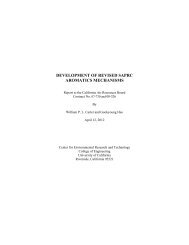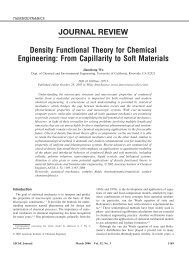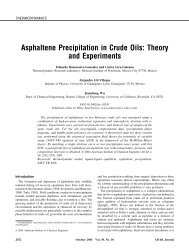Gas-Phase Ozone Oxidation of Monoterpenes: Gaseous and ...
Gas-Phase Ozone Oxidation of Monoterpenes: Gaseous and ...
Gas-Phase Ozone Oxidation of Monoterpenes: Gaseous and ...
You also want an ePaper? Increase the reach of your titles
YUMPU automatically turns print PDFs into web optimized ePapers that Google loves.
GAS-PHASE OZONE OXIDATION OF MONOTERPENES 239<br />
pinene (275 to 440 ppmv) <strong>and</strong> ozone (179 to 270 ppmv), <strong>and</strong> no OH scavenger. The<br />
very different reaction conditions may account for the different product yields.<br />
The identified products account for 34% <strong>and</strong> 50% <strong>of</strong> the reacted β-pinene carbon<br />
mass in the 6/11/98b <strong>and</strong> 6/17/98b experiments, respectively. Products with<br />
a yield exceeding >1% include nopinone (15.8–17.0%), hydroxy pina ketones<br />
(7.3–9.0%), 3-oxo-pina-ketone (1.8–7.7%), norpinonic acid <strong>and</strong> its isomers (5.9–<br />
16.5%), <strong>and</strong> pinic acid (2.6–3.7%). The identified products are estimated to account<br />
for 98% <strong>and</strong> 83% <strong>of</strong> the organic aerosol mass formed in the two β-pinene/O 3<br />
experiments. Norpinonic acid <strong>and</strong> its isomers, pinic acid <strong>and</strong> hydroxy pina ketones<br />
are SOA components that contribute to more than 10% <strong>of</strong> the organic aerosol mass.<br />
The 6/17/98b experiment has a much higher percentage <strong>of</strong> reacted β-pinene<br />
accounted for by the identified products than the 6/11/98b experiment, as two major<br />
products, norpinonic acid <strong>and</strong> its isomers <strong>and</strong> 3-oxo-pina-ketone, were observed to<br />
have much higher gas-phase yields in the 6/17/98b experiment (Table IX). The<br />
two β-pinene/O 3 experiments were conducted under different initial conditions,<br />
i.e., ozone was present in an excess amount in the 6/11/98b experiment whereas<br />
β-pinene is in excess in the 6/17/98b experiment (Table I). The variation between<br />
the two experiments can not be accounted for by measurement error alone. It is<br />
possible the different initial reaction conditions are responsible for the variation,<br />
but a satisfactory explanation is not possible without further experiments designed<br />
to systematically examine the effects <strong>of</strong> different reaction conditions on product<br />
yields.<br />
The functional group distribution <strong>of</strong> SOA components from the β-pinene/O 3<br />
experiments is comparable to results obtained by Palen et al. (1992) using Fourier<br />
transform infrared spectrometry (FTIR). Palen et al. analyzed aerosol samples<br />
generated from an experiment with 8 ppmv O 3 <strong>and</strong> 14.5 ppmv β-pinene. Their<br />
results indicated that an average aerosol-phase product molecule contained one<br />
ketone group, 0.7 alcohol groups, <strong>and</strong> 0.4 carboxylic groups. For the 6/17/98<br />
β-pinene/O 3 experiment where excessive β-pinene was used, our GC/MS analysis<br />
showed that the average aerosol molecule contained about one ketone group, 0.2<br />
alcohol groups, <strong>and</strong> 0.8 carboxylic groups.<br />
4.2. SABINENE<br />
Table X shows yields <strong>of</strong> individual products in the gas <strong>and</strong> aerosol phases, as well<br />
as the total yields <strong>of</strong> both phases in the sabinene/O 3 experiment. Identified products<br />
in both the gas <strong>and</strong> aerosol phases account for 57% <strong>of</strong> the reacted sabinene carbon<br />
mass. Products with a molar yield exceeding 1% include sabina ketone (47%),<br />
hydroxy sabina ketone (7%), norsabinonic acid <strong>and</strong> its isomers (5%), pinic acid<br />
(1%), <strong>and</strong> sabinic acid (1%).<br />
All the products added together account for 100% <strong>of</strong> the organic aerosol mass<br />
formed. The 100% yield is rather fortuitous, <strong>and</strong> it is associated with an uncertainty<br />
factor resulting from the approximations made for response factors <strong>and</strong> SOA
















